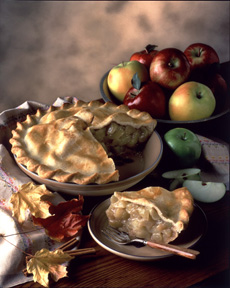TIP OF THE DAY: Bake A Pie For National Pie Day
|
January 23rd is National Pie Day (see all the American food holidays). Which pie should you choose for your celebration? The pie-sibilities are endless. The most popular pies, according to a survey* sponsored by the makers of Mrs. Smith’s and Edwards desserts: |
|
|
|
1. Pecan pie The next 10 most-searched pies: banana cream, chocolate pecan, Dutch apple (with a crumb topping of flour, brown sugar, oats and butter), blueberry, coconut cream pie, mud pie, egg custard pie, lemon pie, French silk pie (a variation of chocolate pie) and custard pie. |
||
 The original pies were savory, not sweet: meat pies were the rule for the first thousand years or more. They were rectangular, not round; and the crust was often made just to hold the contents (it wasn’t eaten). Photo of chicken pot pie courtesy MackenzieLtd.com. |
THE HISTORY OF PIE While the French have the reputation as the great pastry makers, the ancient Egyptians, who were great bread bakers, worked out the details of early pastry. Theirs were savory pies: a dough of flour and water paste was made to wrap around meat and soak up the juices as it cooked. The dough was used as a vessel to cook the contents—in lieu of an expensive baking pan—and was typically not eaten. Pastry was further developed in the Middle East; it was brought to Mediterranean Europe by the Muslims in the 7th century. Another leap forward occurred in the 11th century, when Crusaders brought phyllo dough back to Northern Europe (the First Crusade was 1096 to 1099). Greek and Roman pastry did not progress further because both cultures used oil, which can’t create a stiff pastry. In medieval Northern Europe, the traditional use of lard and butter instead of oil for cooking hastened the development of other pastry types. Pies crusts developed, and the stiff pie pastry was used to provide a casing for various fillings. |
|
|
Pyes (pies), still predominantly meat, originally appeared in England as early as the 12th century. The crust of the pie was referred to as the “coffyn” because of its rectangular coffin shape. There was actually more crust than filling. Fruit pies or tarts (pasties) were probably first made in the 1500s. English tradition credits making the first cherry pie to Queen Elizabeth I (credit actually goes to anonymous chefs who toiled in her kitchens). By the 17th century, flaky and puff pastries were in use, developed by French and Italian Renaissance chefs. Pastry began to become highly decorated, with pastry chefs working intricate patterns on the crusts. Pie came to America with the first English settlers. The early colonists cooked their pies in long narrow pans called coffins. As with the Romans, those early American pie crusts often were not eaten, but simply created to hold the filling during baking. It was during the American Revolution that the term crust was used instead of coffyn, and the tradition of tasty crusts was on its way.
|
||



